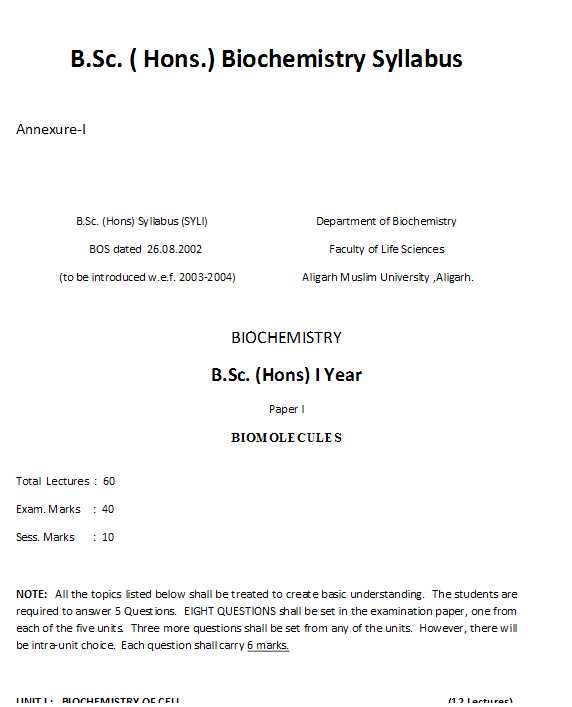|
#2
14th March 2017, 04:06 PM
| |||
| |||
| Re: Aligarh Muslim University Bsc
As you want to download syllabus of B.SC Hons. Biochemistry Course of Aligarh Muslim University, so here I am providing complete syllabus: Aligarh Muslim University B.SC Hons. Biochemistry Syllabus YEAR I Paper I BIOMOLECULES UNIT I : BIOCHEMISTRY OF CELL (12 Lectures) Definition and scope of biochemistry, cellular basis of life, molecular composition of cells, elements and compounds of life; Biomembranes - plasma membrane and membranes of sub-cellular organelles. Biochemical functions of cell organelles (revise your knowledge of ultrastructure of cell as it shall not be discussed); molecular logic of cell; unit of length used in cell biology and biochemistry; suitability of organic molecules as biomolecules, dimensions of cellular molecules and their packing in the cell. Origin of Life: Time scale of chemical and biological evolution; some working assumptions for origin of life, conditions leading to abiotic origin and organic compounds, current concepts of origin of life. Water as Solvent of Life: Physical properties and hydrogen bonding of H2O; structure of liquid water and its solvent properties, hydrophobic interactions; ionisation of H2O, ion product of water, the pH scale, definition of buffer, relationship between pH and pKa (Henderson-Hasselbach equation); fitness of aqueous environment for living organisms. UNIT II : PROTEINS AND ENZYMES (14 Lectures) Proteins  efinition, protein content of various type of cells; elemental composition, biological function of proteins; structure of twenty alpha-amino acids commonly found in proteins, Zwitterion nature of amino acid in aqeous solutions, abbreviations and classification of 20 amino acids, essential amino acids nutritive value of proteins; peptide bond formation, nomenclature of peptides backbone structure of protein/polypeptide, definition of N-terminal and C-terminal amino acids, properties of amino acids/proteins arising from their dipolar nature; basic understanding of primary, secondary, tertiary, quaternary and domain structure of proteins/peptides, classification of proteins based on solubility and shape; elementary ideas on protein denaturation and loss of biological activity. efinition, protein content of various type of cells; elemental composition, biological function of proteins; structure of twenty alpha-amino acids commonly found in proteins, Zwitterion nature of amino acid in aqeous solutions, abbreviations and classification of 20 amino acids, essential amino acids nutritive value of proteins; peptide bond formation, nomenclature of peptides backbone structure of protein/polypeptide, definition of N-terminal and C-terminal amino acids, properties of amino acids/proteins arising from their dipolar nature; basic understanding of primary, secondary, tertiary, quaternary and domain structure of proteins/peptides, classification of proteins based on solubility and shape; elementary ideas on protein denaturation and loss of biological activity.Enzymes: Concept of enzyme nature of enzymes catalysed reaction, active site of enzymes, Michaelis-Menton equation, effect of temp & pH; role of co-enzymes, prosthetic groups, activator and inhibitors in enzyme catalysed reaction. UNIT III : CARBOHYDRATES: (10 Lectures) Definition, empirical formulae & biological functions; Classification into monosaccharides (aldoses and ketoses), oligosaccharides & polysaccharides; Optical isomerism, open chain and ring structure of carbohydrates, mutarotation, structure of biologically important carbohydrates (D-glucose, D-galactose, D-mannose, D-fructose, Dribose, D-2, deoxyribose, D-maltose, D-lactose, D-sucrose), polysaccharides, starch, cellulose, glycogen and mucopolysaccarides, suitability of polysaccharides as storage material in plants. UNIT IV: LIPIDS ( 12 Lectures) Definition, biological function, general formulae of fatty acids, essential and nonessential fatty acids, nomenclature and properties, classification of lipids into simple, complex and derived lipids, the general structure and function of major lipid subclasses: acyalglycerols, phosphoglycerides, sphingolipids, waxes, terpenes, steriods, and prostaglandins; suitability of triglycerides as storage lipids; analytical characterization of fats and oils - saponification number and iodine number. UNIT V: NUCLEIC ACIDS ( 12 Lectures) Nature of genetic material; evidence that DNA is the genetic material, generalized structural plan of nucleic acid, nomenclature used in writing structure of nucleotides and nucleic acids, features of DNA double helix; Size of DNA in procaryotic and eukaryotic cells, central dogma of molecular biology; Gene, genome, chromosome, basic ideas of DNA replication, transcription and protein biosynthesis, role of DNA as genetic material, genetic code, codons, deciphering the genetic code, molecular basis of mutation. Paper II MICROBIOLOGY AND VIROLOGY UNIT I : CLASSIFICATION OF MICROORGANISMS (12 Lectures) Types of microorganisms - general characteristics of main groups of microorganisms viz. prokaryotes, eukaryotes and archae; criteria used in the classification of bacteria - morphology, cytology, genetics, host specialization, serology, physiology etc; Mycoplasma. UNIT II : MORPHOLOGY, NUTRITION & PHYSIOLOGY OF BACTERIA (12 Lectures) (a) General organization of bacterial cells - gram positive and gram negative organisms; structure and function of peptidoglycan in gram positive and gram negative organisms; function of polymeric components in outer membrane and acidic polymers in gram negative organisms. (b) Nutrition, physiology and growth of bacterial cells,different phases of growth, use of different types of media in bacterial cultivation. UNIT III : APPLIED MICROBIOLOGY AND BACTERIA GENETICS (12 Lectures) Role of bacteria in food spoilage, fermentation, food-borne infections and sewage (domestic and industrial) treatment, biofertilizer. Microbial genetics and differentiation - Adaptation and mutation: types of mutation and induction of mutation; bacterial transformation, conjugation, sex types, transduction, transfection, protoplast fusion, genetic recombination, plasmids, IS elements and transposons   To get full syllabus, download the file......................... |